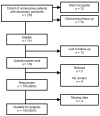Long-term prevalence of post-traumatic stress disorder symptoms in patients after secondary peritonitis
- PMID: 17319937
- PMCID: PMC2151910
- DOI: 10.1186/cc5710
Long-term prevalence of post-traumatic stress disorder symptoms in patients after secondary peritonitis
Abstract
Introduction: The aim of this study was to determine the long-term prevalence of post-traumatic stress disorder (PTSD) symptomology in patients following secondary peritonitis and to determine whether the prevalence of PTSD-related symptoms differed between patients admitted to the intensive care unit (ICU) and patients admitted only to the surgical ward.
Method: A retrospective cohort of consecutive patients treated for secondary peritonitis was sent a postal survey containing a self-report questionnaire, namely the Post-traumatic Stress Syndrome 10-question inventory (PTSS-10). From a database of 278 patients undergoing surgery for secondary peritonitis between 1994 and 2000, 131 patients were long-term survivors (follow-up period at least four years) and were eligible for inclusion in our study, conducted at a tertiary referral hospital in Amsterdam, The Netherlands.
Results: The response rate was 86%, yielding a cohort of 100 patients; 61% of these patients had been admitted to the ICU. PTSD-related symptoms were found in 24% (95% confidence interval 17% to 33%) of patients when a PTSS-10 score of 35 was chosen as the cutoff, whereas the prevalence of PTSD symptomology when borderline patients scoring 27 points or more were included was 38% (95% confidence interval 29% to 48%). In a multivariate analyses controlling for age, sex, Acute Physiology and Chronic Health Evaluation II (APACHE II) score, number of relaparotomies and length of hospital stay, the likelihood of ICU-admitted patients having PTSD symptomology was 4.3 times higher (95% confidence interval 1.11 to 16.5) than patients not admitted to the ICU, using a PTSS-10 score cutoff of 35 or greater. Older patients and males were less likely to report PTSD symptoms.
Conclusion: Nearly a quarter of patients receiving surgical treatment for secondary peritonitis developed PTSD symptoms. Patients admitted to the ICU were at significantly greater risk for having PTSD symptoms after adjusting for baseline differences, in particular age.
Comment in
-
Medical post-traumatic stress disorder: catching up with the cutting edge in stress research.Crit Care. 2007;11(1):118. doi: 10.1186/cc5697. Crit Care. 2007. PMID: 17338831 Free PMC article.
References
-
- Haraldsen P, Andersson R. Quality of life, morbidity, and mortality after surgical intensive care: a follow-up study of patients treated for abdominal sepsis in the surgical intensive care unit. Eur J Surg Suppl. 2003;588:23–27. - PubMed
-
- Capuzzo M, Valpondi V, Cingolani E, Gianstefani G, De Luca S, Grassi L, Alvisi R. Post-traumatic stress disorder-related symptoms after intensive care. Minerva Anestesiol. 2005;71:167–179. - PubMed
-
- Nickel M, Leiberich P, Nickel C, Tritt K, Mitterlehner F, Rother W, Loew T. The occurrence of posttraumatic stress disorder in patients following intensive care treatment: a cross-sectional study in a random sample. J Intensive Care Med. 2004;19:285–290. doi: 10.1177/0885066604267684. - DOI - PubMed
MeSH terms
LinkOut - more resources
Full Text Sources
Medical


